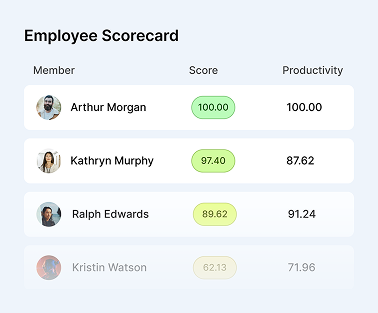
Companies with strong cultures grow revenue four times faster and that has become a key differentiator for attracting talent, driving productivity, and achieving long-term success.
A strong company culture doesn’t just happen — it requires intentional effort, clear values, and leadership commitment.
This ultimate guide will walk you through everything you need to know to build a vibrant, empowering, and sustainable company culture that fuels growth and keeps your team engaged.
What Is Company Culture?
Company culture is the collective personality of your organization — the shared values, beliefs, behaviors, and norms that shape how people work together. It influences decision-making, collaboration, and employee satisfaction.
Culture isn’t just about fun perks or office aesthetics. It’s the foundation that defines how your team interacts, solves problems, and aligns around common goals. It’s reflected in how employees feel about coming to work every day and how they treat one another.
When culture is strong, it acts as an invisible glue holding the organization together — especially important in times of change or growth. It can also be a company’s most sustainable competitive advantage, hard for competitors to replicate.

Why Building a Strong Company Culture Matters
A strong culture helps you:
✅ Attract and retain top talent in a competitive market
✅ Boost employee engagement and productivity by fostering ownership
✅ Encourage innovation by creating a safe space for ideas and risk-taking
✅ Improve customer experience as motivated employees deliver better service
✅ Create a sense of belonging and shared purpose, reducing turnover
✅ Build resilience to navigate challenges and market shifts effectively
Culture directly impacts your bottom line. According to studies, companies with strong cultures have higher profitability and lower employee turnover.
In contrast, weak or toxic cultures cause disengagement, burnout, and costly mistakes.
Let’s divide it into steps:
Step 1: Define Your Core Values and Purpose
Begin by pinpointing the handful of principles that truly drive your organization—values that feel alive, not just decorative words on a poster.
Gather a diverse group of leaders and front-line employees to explore what your company stands for beyond profit margins: perhaps innovation that uplifts communities or a commitment to learning that fuels every role.
Once you’ve named your values, bring them to life in real moments—a customer call, a project kickoff, a tough decision—so everyone sees how those values guide choices.
Finally, articulate a clear purpose—the answer to “why we exist”—that connects daily tasks to a larger mission. When people can trace their morning to-dos back to that purpose, they’ll carry a deeper sense of pride into every challenge.
Step 2: Lead by Example
Culture isn’t decreed from above; it’s embodied in every leader’s actions. If honesty is a core value, leaders must deliver feedback with openness, admit missteps without defensiveness, and invite candid dialogue when tension arises.
When stress or change puts pressure on your team, those top-down practices become a lifeline of trust—or the fault lines of distrust.
Encourage managers to model vulnerability by sharing their own learning moments, then spotlight the team’s collective wins.
Investing in leadership training—whether on emotional intelligence or inclusive communication—reinforces the idea that guiding culture is as essential as meeting financial targets.
Maximize productivity of your business
Track employee productivity and simplify work with them
Step 3: Hire for Culture Fit and Add
When you talk to candidates, don’t just quiz them on skills; invite them to share a story about a time they faced failure, rallied a team, or challenged the status quo. Look for people whose instincts align with your values, but also whose fresh viewpoints will spark growth.
Once they accept the offer, immerse them in your narrative: pair them with a veteran mentor, introduce them to the rituals that matter—be it a weekly brainstorm or a monthly town hall—and explain not only what you do but how and why you do it.
By weaving new hires into the cultural fabric from day one, you transform them from outsiders into engaged architects of your future.
Step 4: Communicate Clearly and Frequently
Keeping culture vibrant means making it a topic of conversation, not a footnote in a memo.
Open your all-hands meetings with a brief reflection on how recent decisions echoed your values. For example, launch an internal blog where teams share stories of small victories and hard lessons.
At the same time, create safe channels—anonymous suggestion boxes or moderated forums—so ideas and concerns flow upward without fear.
When leaders respond openly to feedback, even with a simple “Here’s what we’ll try next,” it sends a clear message: culture evolves through collective input, and every voice has weight.

Step 5: Empower Employees and Encourage Ownership
True empowerment means trusting people to make meaningful decisions, even when those choices carry risk. Set clear guardrails—budgets, timelines, quality standards—but then step back and let teams chart their own course.
Carve out “innovation hours” where anyone can pitch and prototype a bold idea, regardless of title. Celebrate experiments that don’t pan out as learning wins, not failures.
As employees see ideas move from concept to execution under their own steam, they develop a sense of ownership that fuels both engagement and breakthrough thinking.
Step 6: Foster Collaboration and Inclusion
An inclusive culture amplifies every voice, especially those who might otherwise stay quiet.
Break down silos by hosting cross-department “hackathons” or problem-solving workshops, where marketers, engineers, and operations specialists tackle shared challenges side by side.
You also have another powerful tool: offer training that surfaces unconscious biases and builds habits of active listening. When someone raises a new perspective, acknowledge it publicly and weave it into the discussion.
By treating diversity of thought as an everyday asset, you unlock creative solutions and reinforce the idea that everyone belongs.
Step 7: Recognize and Celebrate Success
Recognition doesn’t require a budget line—it only demands sincerity. A few heartfelt sentences praising a colleague at the end of a meeting can resonate far longer than a generic company-wide announcement.
Encourage peer-to-peer shout-outs, perhaps with a dedicated Slack channel or a rotating “culture champion” award. Link each acknowledgment back to your core values: “I’m celebrating Maria’s quick thinking this week—she truly lived our value of customer obsession when she…”
Over time, these moments of gratitude become cultural touchstones that motivate everyone to raise the bar.

Step 8: Support Well-being and Work-Life Balance
Healthy cultures care for people beyond their productivity. Make it normal—and expected—to take real vacations, to log off after hours, and to use mental health resources without stigma.
Consider brief “well-being check-ins” during team meetings or optional wellness workshops that address stress management and financial planning.
When leaders visibly honor these boundaries—by declining late-night emails or blocking focus time on their calendars—they lay the groundwork for a sustainable pace that keeps talent energized rather than exhausted.
Step 9: Continuously Evolve Your Culture
What resonates with a 20-person startup often creaks under the weight of 200 employees.
Treat your culture as a living system: solicit regular feedback through pulse surveys, small-group interviews, or exit conversations. Analyze trends—where do people feel stuck, and where do they thrive? Then empower culture “ambassadors” across teams to pilot tweaks, whether that’s a new ritual, a clearer decision-making framework, or a refreshed value statement.
By iterating thoughtfully—testing, measuring, refining—you ensure your culture remains a source of strength, not a relic of past successes.
Additional Insights: The Role of Remote and Hybrid Work
The rise of remote and hybrid work models makes culture more important — and more challenging — than ever.
Without physical proximity, companies must be deliberate about creating connection and alignment.
This includes virtual rituals, clear communication norms, and technology that supports collaboration.
Building trust remotely requires transparency and empathy. Culture can be a strong anchor, helping employees feel engaged and motivated regardless of
location.

Conclusion: The Company’s Greatest Asset
Strong culture isn’t built in a sprint—it’s the result of relentless, authentic effort. It requires ongoing commitment, authentic leadership, and a focus on people as much as processes.
When done right, culture becomes your company’s greatest asset—fueling engagement, innovation, and success that lasts.
Start today by defining your values and living them every day. Your team—and your business—will thank you.
– The Monitask Team
FAQ: Building a Strong Company Culture
Can company culture be changed if it’s currently weak or toxic?
Yes, but it requires commitment from leadership, honest assessment, and often a cultural transformation plan. Change starts with transparency, addressing pain points, and engaging employees in the process.
What role do leaders play in shaping culture?
Leaders set the tone by modeling values and behaviors. Their communication style, decision-making, and how they treat employees profoundly influence the culture.
How do you balance company culture with remote or hybrid work?
Intentional communication, virtual rituals, and leveraging collaboration tools help maintain culture across distances. Trust, empathy, and inclusion become even more important in remote settings.
Which metrics best gauge company culture?
- eNPS – Your Employee Net Promoter Score shows overall engagement (aim for +20 or higher).
- Turnover rate – Rising voluntary exits, especially among top performers, often signal cultural issues.
- PTO usage & absenteeism – Healthy vacation take-up and low unplanned absences indicate work-life balance.
- Pulse-survey trends – Frequent, focused surveys on trust and psychological safety surface emerging concerns.
Combine these with spot interviews or exit-interview themes to understand the “why” behind the numbers.



